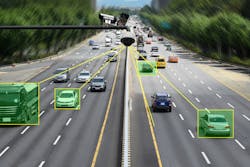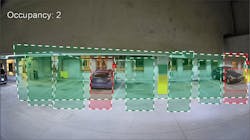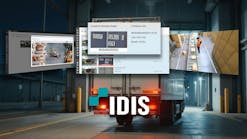This article originally appeared in the July 2020 issue of Security Business magazine. When sharing, don’t forget to mention @SecBusinessMag on Twitter and Security Business magazine on LinkedIn.
Safeguarding people and property remain top priorities for the industry today, but security is transforming into more than just creating a safe environment – the Internet of Things and increasing connectivity are changing and expanding the role of security devices. This is possible through the increase of intelligent security devices, such as IP cameras with built-in video analytics.
Video analytics is a value-add that integrators can sell to customers as a method to solving security problems that was not possible in the past, or to solve them in a much more efficient way. The technology is improving rapidly, making it more useful and opening opportunities to enable video cameras to expand beyond security applications – thereby creating new ways for integrators to grow their businesses.
Beyond Security
With built-in intelligence, the video security camera is no longer a passive system that simply observes and records events before making footage available for playback. In these systems, typically only 10 percent of the video data is ever used.
With advancements in the reliability of video analytics, video security cameras are now empowered with analytics that can help users to manage and improve the value of the vast quantities of video data. It acts as a never-tiring assistant within a system, capturing data on everything that happens in each monitored scene.
In today's increasingly connected world, the smart video security camera becomes a versatile sensor that enables other "things" to extract and interpret this rich data to bring security, life safety and business intelligence to another level – enabling nearly 100 percent utilization of the video data.
It captures the data and feeds it to solutions that collect it from multiple devices, aggregating and interpreting it to provide valuable information and insights. As a result, intelligence enables data-driven solutions based on the security infrastructure. With these solutions, integrators can improve their customers' total cost of ownership and return on investment through the ability to increase efficiency, reduce costs, and create more business opportunities with new revenue streams.
Analytics in Action
Parking Management: Intelligent cameras can help large organizations or city planners monitor parking space utilization. In lots, cameras can count the number of open parking spaces, specialized spots – such as those for handicap or electric vehicles – or track ingress and egress, and relay this data to the video and parking management systems without the need for or expense of a series ofground sensors. Sharing this information and alternative parking locations on a dynamic message sign can help people to find parking faster, improve efficiency, and reduce emissions.
In addition, cities or parking lot managers can take advantage of machine learning to determine how long a vehicle remains in a time-limited space, and alert to vehicles exceeding a certain time threshold to boost revenue streams from parking violations. This same concept applies at the airport curbside for passenger drop-off and pick up where vehicle-parking time is restricted. Video analytics with machine learning can detect and alert law enforcement to vehicles parked exceeding this maximum time limit. Machine learning enables video analytics to function in more accurate and application-specific ways, as it can identify objects and situations within a scene that are defined by the user in addition to standard analytics rules.
Roadways: Intelligent cameras can improve safety by alerting to risks on the road with automatic incident detection and verification for slow or stopped vehicles, queues of vehicles at exit ramps, vehicles traveling the wrong way, objects in the road – such as lost cargo – and other traffic events. Video sensors can also classify objects as cars, trucks, bicycles, and pedestrians, and detect speed and trajectory – continuously collecting real-time data. Armed with this valuable information, city traffic planning directors and senior traffic engineers can analyze flow patterns on networks of roadways for implementing new policies that result in safer and more efficient intersections.
Airports: Machine learning can also enable intelligent cameras to gather data in heavily controlled transport environments, such as airports, where the awareness of traffic flow and plane status is critical. Data collected could include information on how long an airplane parks at a terminal, the time it takes to load passengers’ luggage, or how long it takes to refuel a plane. This information is helpful for speeding the turnaround time for passengers and planes, improving efficiencies at the airport, and reducing costs for airlines.
Retail stores: Video security cameras can capture anonymous shopper traffic data that provides merchandisers and operations managers with actionable insights. With cloud-based processing, the data transforms into traffic visualization tools that show where customers walk, dwell, and engage with product placements, giving merchandisers the information they need to maximize customer engagement and increase sales. By analyzing the store traffic data captured, operations managers can enhance service by adjusting staffing to accommodate peak days and times, thereby increasing customer loyalty. This can all be done without video streams ever leaving the retailer’s premise, thus maintaining shopper’s privacy.
Corporate facilities: In a large building, sensors can provide data on occupancy to help facility managers determine patterns in arrival and departure times of employees on each floor to better manage costs associated with HVAC and lighting. Data gathered by security devices that easily translates into consumable visualizations provides organizations with insights for reducing costs.
Lay the Foundation
Capturing data and using video analytics to trigger other systems requires high-quality images to ensure reliability and accuracy. Quality images are essential even in situations where objects are moving, or there are poor lighting conditions or other adverse conditions. If image quality is lacking, the accuracy of the data is at risk, as is any video evidence.
Video analytics technology must also be robust enough to differentiate between genuine events and false triggers such as snow, moving trees, rain, hail and water reflections that can make video data difficult to interpret. It should also be trainable. The camera should be able to retain information on user-defined objects and situations and refer to these new learnings when processing scenes.
IoT devices, by definition, provide the ability to be used in many ways, but now there is an expectation that, through software, we can expect a dramatic increase in functionality over time. With the right platform, devices like IP cameras have the potential to be as flexible as a smart phone, creating unlimited new uses within their lifetimes.
Capturing the data and putting it in a usable structure is a foundational piece. Just as important is funneling that vast amount of raw data into a platform that transforms it into intelligence. This transformation is key to enabling both automated and human decisions. This is a quickly evolving area with exciting advances in artificial intelligence powering new abilities every day.
Anticipate Customer Needs
As the proliferation of connected devices continues to grow, integrators must anticipate how this will change customer requirements and preferences. Extending the role of security devices beyond the standard practice enables solutions designed around the real needs of users to help them address the challenges they face in their businesses and organizations.
This approach will shape the future of security – one where integrators can help security departments make the transition from a pure cost center to a profit center – boosting the value the integrator provides.
Sean Murphy ([email protected]) is the Director of Vertical Markets Development for Bosch Security and Safety Systems. (www.boschsecurity.com). Request more info about the company at www.securityinfowatch.com/10213805.





